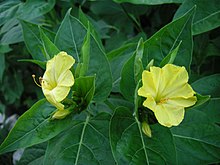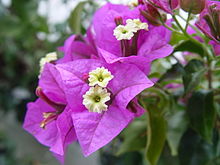| Nyctaginaceae | |
|---|---|

| |
| Garden Four O'Clock (Mirabilis jalapa) flowers | |
| Scientific classification | |
| Kingdom: | Plantae |
| Clade: | Tracheophytes |
| Clade: | Angiosperms |
| Clade: | Eudicots |
| Order: | Caryophyllales |
| Family: | Nyctaginaceae Juss.[1] |
| Tribes | |
| Synonyms | |
| |

Nyctaginaceae, the four o'clock family, is a family of around 33 genera and 290 species of flowering plants, widely distributed in tropical and subtropical regions, with a few representatives in temperate regions. The family has a distinctive fruit type called an accessory fruit or anthocarp, and many genera have extremely large (>100 μm) pollen grains.
The family has been almost universally recognized by plant taxonomists. The APG II system (2003; unchanged from the APG system of 1998), assigns it to the order Caryophyllales in the clade core eudicots.
A phylogenetic study by Levin has justified the combination of Selinocarpus and Ammocodon into the genus Acleisanthes. The genus Izabalea is now considered a synonym of Agonandra, a genus in Opiliaceae. A more recent study by Douglas and Manos clarified the relationships among almost all of the genera in the family and demonstrated that a substantial diversification of herbaceous genera has occurred in arid North America. Many genera of Nyctaginaceae possess unusual characters. Notable examples include sticky bands on the stems between the nodes, cleistogamous flowers (which self-pollinate without opening), or gypsophily, the ability to grow on soils with a high concentration of gypsum.
- ^ Angiosperm Phylogeny Group (2009). "An update of the Angiosperm Phylogeny Group classification for the orders and families of flowering plants: APG III" (PDF). Botanical Journal of the Linnean Society. 161 (2): 105–121. doi:10.1111/j.1095-8339.2009.00996.x. hdl:10654/18083. Retrieved 2013-07-06.
- ^ "Family: Nyctaginaceae Juss., nom. cons". Germplasm Resources Information Network. United States Department of Agriculture. 2003-01-17. Archived from the original on 2009-05-06. Retrieved 2010-10-18.